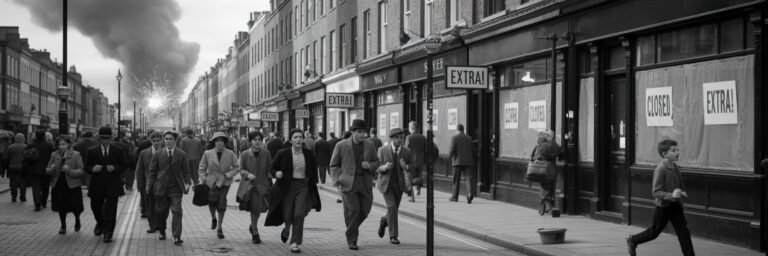During World War II, intelligence and espionage played as crucial a role as military might. One of the greatest intelligence triumphs of the war was the breaking of the Enigma Code, a feat that gave the Allies an unprecedented advantage over Nazi Germany. The efforts of cryptographers at Bletchley Park, led by brilliant minds like Alan Turing, helped shorten the war by at least two years and saved millions of lives.
This article explores the history of the Enigma machine, how the code was cracked, and its impact on the outcome of World War II.
The Enigma Machine: The Nazi Cipher System
What Was the Enigma Machine?
The Enigma machine was a sophisticated electromechanical cipher device used by Nazi Germany to encode secret military messages. Originally designed in the 1920s for commercial use, it was later adopted by the German military, navy, and intelligence agencies.
How Did It Work?
- The machine consisted of rotors, plugboards, and a keyboard.
- Each time a letter was typed, the machine scrambled it into another letter, creating a nearly unbreakable code.
- The machine’s settings changed daily, meaning that even if one message was decoded, future messages remained secure.
- The complexity of Enigma meant there were over 150 quintillion possible settings, making traditional decryption methods useless.
Early Attempts to Break Enigma
Before the British began their codebreaking efforts, Polish cryptographers had already made significant progress in decrypting Enigma communications.
Poland’s Pioneering Work
In the 1930s, Polish mathematicians Marian Rejewski, Jerzy Różycki, and Henryk Zygalski reverse-engineered an early version of the Enigma machine. They built the first decryption devices, known as the Bomba, to break Enigma codes.
Sharing the Secret with the Allies
With the looming threat of war, Poland passed their Enigma-breaking knowledge to Britain and France in 1939, laying the foundation for future breakthroughs at Bletchley Park.
Bletchley Park: The Codebreaking Headquarters
Bletchley Park, a secret facility in Buckinghamshire, England, became the center of Allied codebreaking efforts. The most famous codebreaker at Bletchley Park was Alan Turing, a brilliant mathematician who played a key role in cracking Enigma.
Alan Turing and the Bombe Machine
Turing, along with fellow cryptographers like Gordon Welchman and Joan Clarke, developed a powerful machine called the Bombe.
- The Bombe could quickly test Enigma settings, automating the decryption process.
- By cross-referencing intercepted messages with known German words (such as “weather” or “Heil Hitler”), the Bombe could reduce the number of possible settings significantly.
- By 1941, the British were regularly deciphering German messages, providing vital intelligence to the Allies.
The Role of the “Ultra” Intelligence
The decrypted Enigma messages were classified as “Ultra” intelligence, meaning they were so valuable that their existence was kept top secret. Even frontline commanders were often unaware of the source of their intelligence.
Key Contributions to the War Effort
1. The Battle of the Atlantic
- German U-boats threatened to starve Britain by sinking supply convoys in the Atlantic.
- With decrypted Enigma messages, the Allies tracked U-boat movements and adjusted convoy routes to avoid attacks.
- By mid-1943, the tide of the Battle of the Atlantic had turned, and the U-boat threat was significantly reduced.
2. The North African Campaign
- British forces in North Africa used Enigma intelligence to outmaneuver German General Erwin Rommel’s forces.
- Operation Torch (1942), the Allied invasion of North Africa, benefited from intercepted messages that revealed German defensive strategies.
3. The D-Day Landings (June 6, 1944)
- Leading up to Operation Overlord, codebreakers fed misinformation to the Germans, making them believe the invasion would occur at Calais instead of Normandy.
- This deception delayed German reinforcements, contributing to the success of the D-Day landings.
German Efforts to Strengthen Enigma
Despite the Allies’ successes, the Germans did not realize their code had been broken for much of the war. However, they attempted several measures to make Enigma more secure:
- Adding more rotors to Enigma machines to increase complexity.
- Introducing the Lorenz cipher, a more advanced system used for high-level communications.
- Increasing operational security by reducing repeated phrases and predictable messages.
Despite these changes, Allied cryptographers continued to crack German codes, ensuring the flow of Ultra intelligence remained steady.
The Legacy of the Enigma Codebreakers
1. The Birth of Modern Computing
Alan Turing’s work at Bletchley Park laid the foundation for modern computer science. His creation of the Bombe machine and later Turing machines influenced the development of early computers.
2. The Cold War and Cybersecurity
The success of codebreaking in World War II led to the rise of cryptography and cybersecurity in the Cold War. Intelligence agencies like the NSA and GCHQ evolved from wartime codebreaking efforts.
3. The Recognition of Unsung Heroes
For decades, the work of Bletchley Park was kept secret. It wasn’t until the 1970s and 1980s that the contributions of Turing and his colleagues became widely known.
- In 2013, Alan Turing was posthumously pardoned by the British government for his conviction related to his homosexuality, which led to his tragic death in 1954.
- Today, Turing is celebrated as a war hero, a father of modern computing, and a champion of artificial intelligence.
How Enigma Codebreakers Changed the War
The breaking of the Enigma Code was one of the greatest intelligence achievements of World War II. By decrypting German messages, the Allies gained a crucial strategic advantage, helping them win key battles and ultimately defeat Nazi Germany.
Without the work of the brilliant minds at Bletchley Park, the war might have dragged on for several more years, resulting in even greater devastation. Their work remains a testament to the power of intelligence, innovation, and perseverance.
Even today, the story of the Enigma codebreakers serves as a reminder of how science and mathematics can change the course of history.






